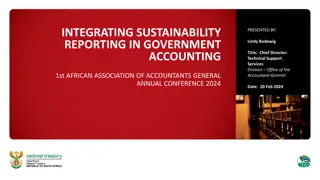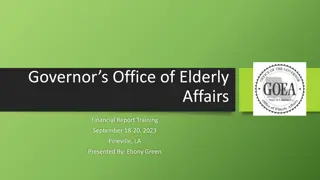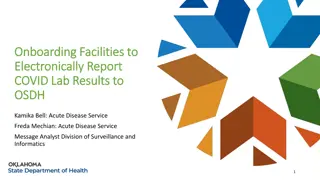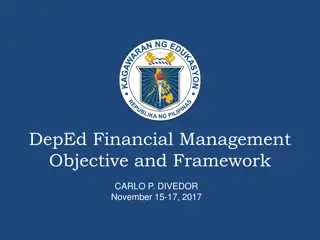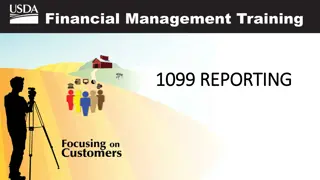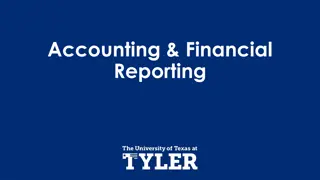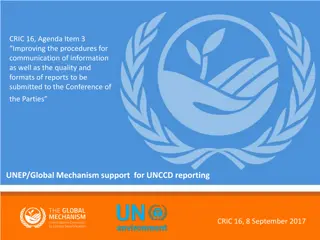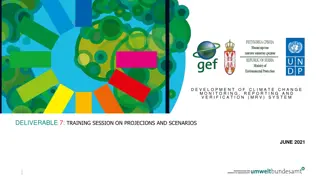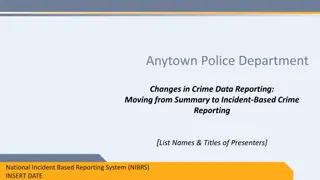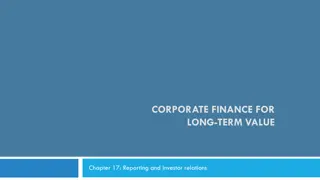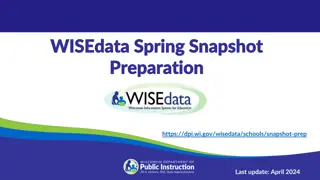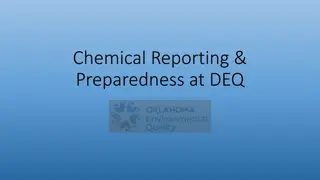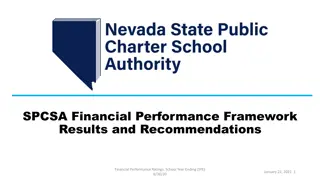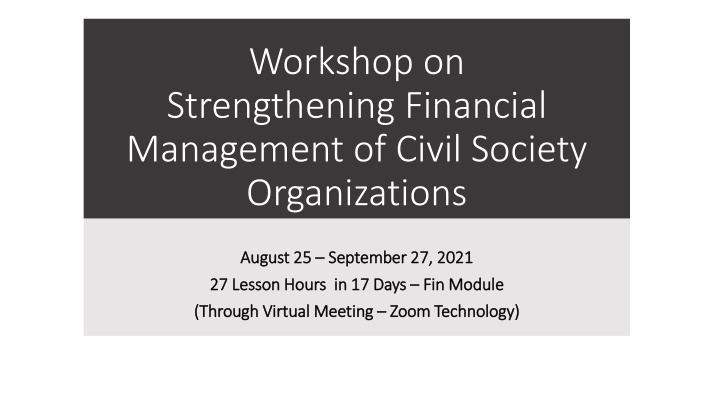
Strengthening Financial Management of Civil Society Organizations: Financial Reporting Module Overview
Enhance your financial management skills with a focus on financial reporting for non-profit organizations. Learn about reporting frameworks, cycles, requirements, and analysis techniques. This module provides tools to improve your organization's financial reporting mechanisms according to industry standards.
Download Presentation

Please find below an Image/Link to download the presentation.
The content on the website is provided AS IS for your information and personal use only. It may not be sold, licensed, or shared on other websites without obtaining consent from the author. If you encounter any issues during the download, it is possible that the publisher has removed the file from their server.
You are allowed to download the files provided on this website for personal or commercial use, subject to the condition that they are used lawfully. All files are the property of their respective owners.
The content on the website is provided AS IS for your information and personal use only. It may not be sold, licensed, or shared on other websites without obtaining consent from the author.
E N D
Presentation Transcript
Workshop on Strengthening Financial Management of Civil Society Organizations August 25 August 25 September 27, 2021 September 27, 2021 27 Lesson Hours in 17 Days 27 Lesson Hours in 17 Days Fin Module (Through Virtual Meeting (Through Virtual Meeting Zoom Technology) Fin Module Zoom Technology)
Module 4: Financial Reporting Mechanism Module 4: Financial Reporting Mechanism About This Module About This Module This module of this workshop is designed, you to learn about the financial reporting framework, financial reporting cycles, financial reporting requirements for nonprofit accounting and analyzing financial statements to understand its current standing etc. The tools and guidance introduced through this module can help you to set up, revise or realign your existing financial reporting mechanism in order to present fairly the financial position, financial performance and cash flows of your organization, followed by Sri Lanka Statement of Recommended Practice for Not- for-Profit Organizations or/and the requirements stipulated by the Sri Lanka Accounting Standards (SLFRS Framework)
Module 4: Financial Reporting Mechanism Module 4: Financial Reporting Mechanism Lesson 8: Lesson 8: Overview of Financial Reporting and Financial Reporting Framework for NPO including Audited Financials and Non Profit Annual Report September 13 September 13 Lesson 9: Lesson 9: Conceptual Framework for Financial Reporting in terms of Sri Lanka Statement of Recommended Practice for Not-for-Profit Organizations and NGOs September 14 September 14 Lesson 10: Lesson 10: Financial Reporting Requirements in terms of SLFRS Framework September 15 September 15 Lesson 11: Lesson 11: NPO Specific Provisions and Significant Accounting Policies Recommended for Not-for-Profit Organizations September 16 September 16 Lesson 12 : Lesson 12 : Analyze a Non Profit Financial Statement as to Evaluate Financial Conditions for a NPO September 17 September 17
Financial Reporting Framework for NPO What is the financial reporting framework? The term financial reporting framework is defined as a set of criteria used to determine measurement, recognition, presentation, and disclosure of all material items appearing in the financial statements.
Financial Reporting Framework for NPO What are the Components of the Conceptual Framework for Financial Reporting? The framework addresses: The objective of general purpose financial reporting. Qualitative characteristics of useful financial information. Financial statements and the reporting entity. The elements of financial statements. Recognition and de-recognition. Measurement. Presentation and disclosure.
Financial Reporting Framework for NPO - Objectives and Importance of Financial Reporting The objective of financial reporting is to track, analyze and report your business income. The purpose of these reports is to examine resource usage, cash flow, business performance and the financial health of the business. This helps you and your investors/contributors make informed decisions about how to manage the business. Financial Reporting is usually considered an end product of Accounting. It provides information to the statutory auditors which in turn facilitates audit
Financial Reporting Framework for NPO - Objectives and Importance of Financial Reporting Financial reporting for various stakeholders & Management Reporting for internal Management of an organization. Both this reporting are important and are an integral part of accounting & reporting system of an organization. But considering the number of stakeholders involved and statutory & other regulatory requirements, Financial Reporting is a very important and critical task of an organization. It is a vital part of Corporate Governance.
Financial Reporting Framework for NPO What are the financial reporting requirements for nonprofit accounting? Statement of Financial Position (SOP) Balance Sheet The SOP is the nonprofit's equivalent of a for-profit company's balance sheet Income Statement - Statement of Financial Activities Statement of Cash Flows Statement of change in equity - Statement of Changes in Accumulated Fund Notes to Financial Statements...
Financial Reporting Framework for NPO What to Include in Your Nonprofit Annual Report? A clear mission and focus. If you could boil down your organization's values and purpose into a single sentence you would have your mission statement. ... Operational and financial highlights including project outcomes Major achievements of the past year. ... Management discussion & analysis Financial statements audited financials An account of major contributions.
Nonprofit Annual Report NGOs (non-governmental organizations) also publish annual reports. The report details all aspects of the NGOs dealings for the past year. This brief guide will try to explain the meaning of an NGO s annual report, along with its objectives, purpose, and best practices when preparing the report.
Nonprofit Annual Report Non-profit annual reports are an in-depth and comprehensive reporting of an NGO s activities. It outlines an NGO s accomplishments. An audited annual accounts section is also added to the report. The report also acts as a marketing tool. For the best results, it is imperative to hire a award- wining annual report design agency. The agency adopts visual storytelling ideas to transform a dull annual report into a strong piece of brand communication.
Nonprofit Annual Report The sections and contents within an NGO annual report slightly differ from a corporate annual report. The sections within an NGO annual report include: An introductory message by the President of the NGO (or a leading authority) List of governing body members NGO organizational chart & governance structure List of projects and activities conducted Achievements of the NGO NGO case studies, with NGO success stories An audited NGO accounts summary
Nonprofit Annual Report The first reason is compliance. The submission of an annual report is mandatory for a non-government organization when filing their returns. The second reason is outreach. The annual report allows NGOs to fellow members, volunteers, partners, and donors. The final reason is building credibility. The branding of the NGO gets various advantages. The major objective is fund-raising. By demonstrating the work done during the preceding year, the NGO can reach out to prospective donors and other agencies for donations.
Nonprofit Annual Report The report also serves as a historical progress report. Publishing an annual report is a good management practice. It acts as inspiration for existing staff, members, volunteers and stakeholders. An annual report encourages engagement and readership, further increasing accountability. The report published by an NGO must be attractive and comprehensive. This can only be achieved by hiring an annual report design expert.
Nonprofit Annual Report The report should contain sufficient information about the NGO s activities, written in simple language. The balance between creativity and information can only be maintained by a design agency. The agency also ensures the report convey a story. Human experiences are showcased through team photos, volunteer testimonies, project case studies, etc. The report needs to also touch upon the impact of the NGO on social issues. Future projects can get a mention as well.
Nonprofit Annual Report Some best practices adopted by an agency are: The audience is always at the forefront. For a non-profit annual report or even a CSR report, the right format makes a huge difference. If donors for the NGO are spending more time online, then a digital format makes sense. A video NGO annual report maybe? This doesn t mean the print annual report is neglected. A regular printed annual report can suffice both online and offline audiences. These design elements elevate a powerful branding tool.
Financial Reporting Cycles What are the financial reporting cycles? The reporting cycle period can be a year, fiscal quarter, or a specified period. The cycle begins with the initial transaction entries in the journal and ends with the published financial statements of the company and the closing of all the temporary accounts.
Financial Reporting Cycles The reporting cycle involves the running, managing, updating, and reporting of a CSO s accounts. The cycle usually runs concurrently with the planning and budgeting cycles. It ensures that the company is ready to begin the following period. A company s planning/budgeting cycles and reporting cycle are usually independent of each other but can involve the same people in their preparation.
Financial Reporting Cycles The reporting cycle involves the running, managing, updating, and reporting of a CSO s accounts. The cycle usually runs concurrently with the planning and budgeting cycles. It ensures that the company is ready to begin the following period. A company s planning/budgeting cycles and reporting cycle are usually independent of each other but can involve the same people in their preparation.
Financial Reporting Cycles The planning cycle involves future estimations in spending and income cash flows while the reporting cycle gives the current standings of the CSO, with regards to assets, revenue, and expenses, after a specified period of business time. Therefore, the planning cycle looks forward in terms of time, while the reporting cycle looks backward on business activity and the most recent standings.
Financial Reporting Cycles Closing the Reporting Cycle Closing the Reporting Cycle The reporting cycle is closed by preparing and publishing financial statements. The reported statements should be cross-checked for errors through auditing to make final adjustments before they are released to the public. The financial statements are discussed with the directors before publishing. The final report should undergo an auditor s scrutiny before being released to the public.
Financial Reporting Cycles Closing the Reporting Cycle Closing the Reporting Cycle An auditor should read in between the lines to highlight any inconsistencies and outright errors in the report. The auditor checks whether the report conforms to the laid out accounting principles and whether it portrays a true financial state of the firm. If the auditor is satisfied with the report and gives an unqualified opinion, the report is released to investors, shareholders, and the general public through the mainstream media or the company s own channels of communication.
How do you Analyze a Non Profit Financial Statement? Analyze the expenses section of the financial statements to identify whether the costs of event management and promotion match up to the income received from the activities. Divide the total contributions excluding government grants by the fundraising expenses to determine the fundraising efficiency ratio.
How do you Analyze a Non Profit Financial Statement?... Key Financial Metrics to Measure Nonprofit Health Liquidity, Program expenses as percentage of total expenses; Sources of unrestricted recurring dollars or rupees; Liabilities as percentage of total assets; Full-cost coverage; Fundraising expenses as percentage of total contributions etc.


